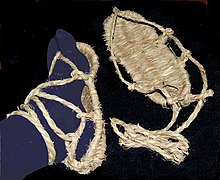Waraji
Waraji (草鞋) (Japanese pronunciation: [w̜aɺadʑi]) are light tie-on sandals, made from (usually straw) ropemaking fibers, that were the standard footwear of the common people in Japan.
[1] Waraji, due to their cheap and rustic nature, are considered to be a very informal type of footwear, and are not worn with formal kimono.
They are typically worn with tabi socks, and are woven so that the wearer's toes generally protrude slightly over the edge of the shoe.
[3] In the Edo period (1603–1867 CE), geta were worn in cities, but anyone making a long journey wore waraji.
[7] There are a number of different ways of tying waraji straps; even historically, there was no standardised method of attaching the shoes to one's feet.



